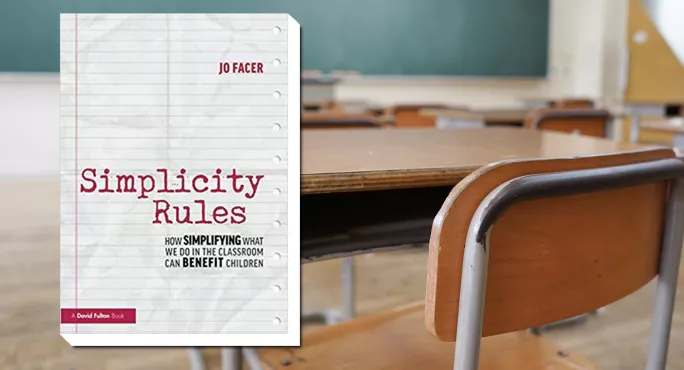- Home
- Book review: Simplicity Rules
Book review: Simplicity Rules

Simplicity Rules
Author: Jo Facer
Publisher: Routledge
Details: 128 pages; £16.99
ISBN: 978 1138488649
Teaching is a complicated business. That’s not meant to be a philosophical musing. I mean that it’s literally complicated, especially when you first start out.
I remember the rising panic when, as a PGCE student, I realised that worksheets, glue, the overhead projector, the register, exercise books and kids without pens all needed to be attended to within the first three minutes of the lesson. Of course, we grow and develop and streamline, and most of these issues cease to be a juggling act within weeks.
The profession has retained an element of complication, though. Jo Facer’s Simplicity Rules looks at what we do in schools, at all levels. It gives clear, practical advice, and makes suggestions for how to strip down our practice and deal wholly with what really matters.
Teachers’ great expectations
This is a book grounded in high expectations for all students, and underpinned by an understanding of how and why we need to reduce teachers’ workload. Oh, and it’s also underpinned by love - love for teaching, love for our subjects, and love and care for our pupils.
Facer lays the groundwork for the book with a research-informed chapter entitled “How children learn”. She gives a clear and concise overview of the fundamental tenets of learning, including an overview of knowledge, skills and understanding, as well as memory. She then gives some practical suggestions as to what this means for the classroom. This introduction to several educational concepts serves as a brilliant starting point for those new to the profession, and sets the tone for what’s to come: practical and workable methods for both the classroom and leadership.
Chapter two, “Good behaviour”, gives practical advice for the classroom, and reserves the last few pages for school leadership. Facer recognises and explores the nuances of context - advice that is probably best suited to those at the newly qualified end of the scale. But the rest of the chapter deals with simplicity in behaviour management, and it’s excellent. The fundamental principle is that everything boils down to a 100 per cent focus on learning.
From here, the chapter explores proactivity, positivity, love, policy, expectations and sanction. Yes, you read that correctly: love. It’s important, and it’s nothing to shy away from. We need to be consistent, and to do the things we do because we love teaching, and we love teaching these specific pupils, and it’s powerful if they know that.
The leadership section, which covers centralised detentions and policy, is concise and rational. School leaders in schools with ineffective behaviour systems would do well to start with this section before commencing on policy design.
Challenging and empowering
The book then moves on to the content of what we should teach, and includes a wonderful interview with Christine Counsell (author, consultant and trainer, former teacher trainer at the University of Cambridge, and director of education for the Inspiration Trust). Counsell is so clear in her thinking, and so measured in approach, that every person involved in curriculum design should read her work. Again, there is no attempt to give us a definite answer on what should be taught; rather, we’re given some considerations to make, during our own curriculum-design work. It’s a challenging and empowering section.
Some of our practice seems to have sprung from the introduction of new technology in schools. Before the existence of projectors in classrooms, PowerPoint didn’t feature as a teaching tool. We’re now at a point where it has taken over and become an expectation. Displaying the objective, the starter, the lesson content (and anything else demanded from above) has become obligatory - yet we managed perfectly well before PowerPoint.
In her chapter “Resources” (in which we’re given actual resources, available online), Facer discusses the ubiquitous PowerPoint and the issues surrounding it. The issues range from the inevitable dark room, to the workload created, to the split in the teacher’s focus. It’s powerful reading and forced me to really consider why we use and rely on it so much, especially in some subject areas. Of course, an alternative is offered: the two-page lesson, complete with examples and explanations of how to use them. I felt a weight lifting as I read these.
Simplicity Rules is packed with theory and ideas for use across schools. There are sections on raising literacy through reading in every lesson - this could be a ground-breaking step for some schools. There are extended comments from experienced teachers, offering practical advice and guidance on impactful change. Those who are very well versed in the work of Lemov, Willingham, Hirsch, and Christodoulou may find that they know some of this already, but even those people will find that this a brilliant read for passing on and sharing during staff CPD sessions. It’s fantastic, and written with love.
Sarah Barker is assistant head and teacher of English at Orchard School, Bristol. She tweets as @mssfax
You can support us by clicking the title link: we may earn a commission from Amazon on any purchase you make, at no extra cost to you.
Keep reading for just £1 per month
You've reached your limit of free articles this month. Subscribe for £1 per month for three months and get:
- Unlimited access to all Tes magazine content
- Exclusive subscriber-only stories
- Award-winning email newsletters



